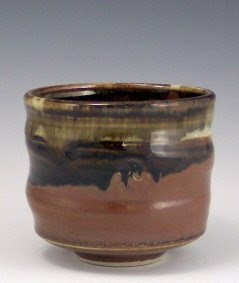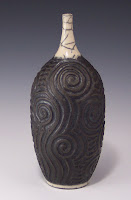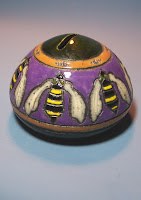 Its 2009 and Happy New Year!
Its 2009 and Happy New Year!Yes my blog has moved again!
Great News!
My blog and website can all be found under one umbrella now at:
http://www.webbpottery.com
Please Join us!
 Its 2009 and Happy New Year!
Its 2009 and Happy New Year!
I’ve had my blog on Blogspot for a few years now but last week my friend Cynthia from Colorado was singing Wordpress praises since moving her blog over from Blogspot. Figured it was worth checking out.
After a couple of days and as many conversations, I ended up transferring all my posts over and am starting to take root. Frankly, I didn’t think it would that easy a sell.
My blogspot URL: http://webbpottery.blogspot.com
My NEW Wordpress URL: http://annewebb.wordpress.com
 Anyone who has taken or has tried to take pictures of pottery knows the challenges to taking a half decent shot. Good pictures can mean the difference between getting into a show, exhibition, or publication or not.
Anyone who has taken or has tried to take pictures of pottery knows the challenges to taking a half decent shot. Good pictures can mean the difference between getting into a show, exhibition, or publication or not. When I was hunting around for photography light fixtures, I found most were way out of my price range. Instead of making a major investment, I found these utility lights at my local hardware store which range in price from $5 to $10.
When I was hunting around for photography light fixtures, I found most were way out of my price range. Instead of making a major investment, I found these utility lights at my local hardware store which range in price from $5 to $10.
 I first checked Etsy out 3 years ago and at that time, I admit, I wasn't terribly impressed. Since then, though, it appears to have has grown exponentially. I was happy to find a growing amount of quality work there as well. What spoke to me the loudest is that things were actually selling and for fair prices too. I have sold quite a few nice pieces on eBay (despite how other potters have said how they had done there) so I am most certainly willing to give Etsy a try too.
I first checked Etsy out 3 years ago and at that time, I admit, I wasn't terribly impressed. Since then, though, it appears to have has grown exponentially. I was happy to find a growing amount of quality work there as well. What spoke to me the loudest is that things were actually selling and for fair prices too. I have sold quite a few nice pieces on eBay (despite how other potters have said how they had done there) so I am most certainly willing to give Etsy a try too. As a craftspeople, this is something we are constantly scratching our heads over and are all too aware of. People want the big houses, the big car, the pre-fab room settings from "Rooms to Go", and would rather buy art/accessories from places like "Pier One" than have something unique made by a local artist or artisan. Cookie cutter people. No originality. See and be seen. Automatons who can't think outside of the box. And the saddest thing, they don't know the difference either. What does this say about our culture? And more importantly, what does this say about our future?
As a craftspeople, this is something we are constantly scratching our heads over and are all too aware of. People want the big houses, the big car, the pre-fab room settings from "Rooms to Go", and would rather buy art/accessories from places like "Pier One" than have something unique made by a local artist or artisan. Cookie cutter people. No originality. See and be seen. Automatons who can't think outside of the box. And the saddest thing, they don't know the difference either. What does this say about our culture? And more importantly, what does this say about our future?

 I have tried many kinds of hand creams to keep my hands from drying out and cracking over the years, but not very many actually penetrate the skin or do much good. The two ones I've had the best luck with are Corn Huskers Lotion and Bee Balm Lotion (BeeBalm is actually my favorite). Both can be bought at my local pharmacy, and the Bee Balm can even be bought through at least one of my pottery suppliers.
I have tried many kinds of hand creams to keep my hands from drying out and cracking over the years, but not very many actually penetrate the skin or do much good. The two ones I've had the best luck with are Corn Huskers Lotion and Bee Balm Lotion (BeeBalm is actually my favorite). Both can be bought at my local pharmacy, and the Bee Balm can even be bought through at least one of my pottery suppliers. I also found these handy dandy little First Aid Cots in the bandage section of the pharmacy, right by the New Skin, bandaids, etc... They roll on like little finger condoms and can even go over a bandage, keeping your digit dry and clean. Much more localized coverage than a latex glove, although just as effective. They work great.
I also found these handy dandy little First Aid Cots in the bandage section of the pharmacy, right by the New Skin, bandaids, etc... They roll on like little finger condoms and can even go over a bandage, keeping your digit dry and clean. Much more localized coverage than a latex glove, although just as effective. They work great. "...eat hearty soups, drink assorted beverages, munch on artisan breads and gourmet cookies, dance to a great band, BAYRUNNER this year, and at the end of the evening take our bowl home."
"...eat hearty soups, drink assorted beverages, munch on artisan breads and gourmet cookies, dance to a great band, BAYRUNNER this year, and at the end of the evening take our bowl home."
 Throwing pots on the wheel, in reality, only represents a small portion of what goes into producing a finished pot. For every two three days of throwing, there are four or 5 days of doing other tasks. Pots still need to be trimmed, have handles attached and decoration applied, and patiently monitored as they dry slowly before they are loaded into the bisque kiln. If they survive the bisque firing , they are then glazed and loaded into the gas kiln. Because our shelves are so badly warped we also "wad" the bottoms of our pots before the final firing (wadding: dry china clay and alumina hydrate mixed and formed into balls which are strategically stuck to the bottom of the pots to evenly support the base of the pot on the kiln shelf).
Throwing pots on the wheel, in reality, only represents a small portion of what goes into producing a finished pot. For every two three days of throwing, there are four or 5 days of doing other tasks. Pots still need to be trimmed, have handles attached and decoration applied, and patiently monitored as they dry slowly before they are loaded into the bisque kiln. If they survive the bisque firing , they are then glazed and loaded into the gas kiln. Because our shelves are so badly warped we also "wad" the bottoms of our pots before the final firing (wadding: dry china clay and alumina hydrate mixed and formed into balls which are strategically stuck to the bottom of the pots to evenly support the base of the pot on the kiln shelf). A friend of mine similarly had some very bad luck with some commercial clay (for which, incidentally, the shipping cost more than the clay) she made all of her pots out of for her fall show season. A week after her big fall sale, a customer brought back $300 worth of pots, then another customer did the same. All or most of the pots had quarter-cent sized hunks of the side of the pot popping off. Lime pop-outs apparently, which can take up to 3 months after the firing to appear. Months of work, large financial commitments (show fee, natural gas, clay, etc), and possibly her reputation tarnished, all because of a faulty raw material or the clay not being mixed properly by the supplier. The supplier was very gracious to replace the clay, but the propane has been burned, the pots have been sold, the money has already been spent, and the remainder of her inventory is questionable... and her pride bruised.
A friend of mine similarly had some very bad luck with some commercial clay (for which, incidentally, the shipping cost more than the clay) she made all of her pots out of for her fall show season. A week after her big fall sale, a customer brought back $300 worth of pots, then another customer did the same. All or most of the pots had quarter-cent sized hunks of the side of the pot popping off. Lime pop-outs apparently, which can take up to 3 months after the firing to appear. Months of work, large financial commitments (show fee, natural gas, clay, etc), and possibly her reputation tarnished, all because of a faulty raw material or the clay not being mixed properly by the supplier. The supplier was very gracious to replace the clay, but the propane has been burned, the pots have been sold, the money has already been spent, and the remainder of her inventory is questionable... and her pride bruised. When you first start learning how to make pottery, you follow your teacher's lead. You follow the same techniques, use the same tools, and emulate your teacher as best as you can. You take what you learn with you throughout your potting career. Lowell's favourite thing to say to students as they start out is "First you learn the rules, then you learn there are no rules". Sure, there are other ways to do the same thing, but as with learning a language, getting a good foundation in the fundamentals is important.
When you first start learning how to make pottery, you follow your teacher's lead. You follow the same techniques, use the same tools, and emulate your teacher as best as you can. You take what you learn with you throughout your potting career. Lowell's favourite thing to say to students as they start out is "First you learn the rules, then you learn there are no rules". Sure, there are other ways to do the same thing, but as with learning a language, getting a good foundation in the fundamentals is important.

 Since I moved my wheel outside, I've noticed a surprising number of new little creatures that I probably wouldn't normally see on my usual trip to the studio. Gekkos, Red headed skinks (a lizard), blue racer skinks, crab spiders, a rainbow of different colored dragonflies, etc., all going about their business seemingly undisturbed by my presence and the constant hum of the wheel. A great place to look for design inspiration.
Since I moved my wheel outside, I've noticed a surprising number of new little creatures that I probably wouldn't normally see on my usual trip to the studio. Gekkos, Red headed skinks (a lizard), blue racer skinks, crab spiders, a rainbow of different colored dragonflies, etc., all going about their business seemingly undisturbed by my presence and the constant hum of the wheel. A great place to look for design inspiration. Absolutely beautiful day out today, here on the coast. While I do miss my fall days in Canada, on days like today, they couldn't be further from my mind. Low humidity, sunny, slight breeze, and in the 80s F.
Absolutely beautiful day out today, here on the coast. While I do miss my fall days in Canada, on days like today, they couldn't be further from my mind. Low humidity, sunny, slight breeze, and in the 80s F. I think I may do it all over again tomorrow. No rain in the forecast until later in the week.
I think I may do it all over again tomorrow. No rain in the forecast until later in the week.
 I've been out of commission for almost a week now with a bad head cold. I have no idea where I picked it up, but it hit me like a truck early Saturday morning as I was getting ready to go run my usual errands.
I've been out of commission for almost a week now with a bad head cold. I have no idea where I picked it up, but it hit me like a truck early Saturday morning as I was getting ready to go run my usual errands.  Took the opportunity to snap a few photos in the gap between when my customer left and my daughter's school bus was to arrive.
Took the opportunity to snap a few photos in the gap between when my customer left and my daughter's school bus was to arrive. 

 Its amazes me, in this day and age, that some people still cannot differentiate between a nude and pornography. I recently talked with someone who even thought a classic like Boticelli's "Birth of Venus" unsuitable for family viewing. I was floored.
Its amazes me, in this day and age, that some people still cannot differentiate between a nude and pornography. I recently talked with someone who even thought a classic like Boticelli's "Birth of Venus" unsuitable for family viewing. I was floored.
"For the Cammidges of Vancouver Island, crafting is a family affair. Andrew, the father, makes clay pots; his wife Joyce dyes and spins wool; and the children are expected to master a craft, too. The family has joined a growing number of Canadians who have turned to crafts as a livelihood. But it's no easy ride: in this CBC report, the owner of a craft supply shop says the odds aren't in favour of the professional craftsperson."
The link to the story: The Crafty Family

"After a lifetime at the potter's wheel, making a bowl is second nature for Michael Cardew. He starts by kneading a hunk of brown clay to remove air bubbles, then positions it on the spinning wheel. He drives his thumbs into the clay, creating a depression in the centre. With intense concentration, Cardew pulls the sides up and out to create a bowl shape. The process, known as throwing, is the focus of this clip from the CBC series Hand and Eye."
Video link: "How to throw a pot" with Michael Cardew
 No, we haven't fallen off the planet, just everywhere but the keyboard.
No, we haven't fallen off the planet, just everywhere but the keyboard.
 One of the pieces we have up on ebay this week:
One of the pieces we have up on ebay this week:
